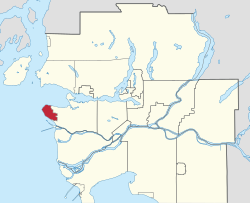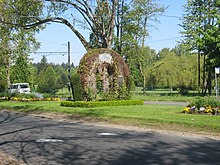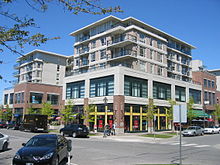

University Endowment Lands
| |
|---|---|
Unincorporated area
| |

Location of the University Endowment Lands in Metro Vancouver.
| |
| Country | Canada |
| Province | British Columbia |
| Regional district | Metro Vancouver |
| Electoral Area | Electoral Area A |
| Government | |
| • MP | Joyce Murray |
| • MLA | David Eby |
| Area | |
| • Total | 14.13 km2 (5.46 sq mi) |
| Elevation | 80 m (260 ft) |
| Population
(2021)
| |
| • Total | 3,193 |
| • Density | 225.97/km2 (585.3/sq mi) |
| Time zone | UTC-8 (PST) |
| • Summer (DST) | UTC-7 (PDT) |
| Postal code span |
V6S, V6T
|
| Area code(s) | 604, 778 |
| Website | University Endowment Lands |
The University Endowment Lands (UEL) is an unincorporated area that lies to the west of the city of Vancouver, British Columbia, Canada, and adjacent to the University of British Columbia (UBC) and the lands associated with that campus. Pacific Spirit Regional Park lies within the UEL. The UEL is part of Metro Vancouver. Mail sent to the UEL is addressed to "Vancouver" rather than the UEL.
The UEL is administered directly by the province and landowners pay their property taxes directly to the provincial government. In a 1995 referendum, UEL residents voted against establishing a municipal governing body.[2]
The University Endowment Lands are located immediately west of the City of Vancouver. Statistics Canada reports a total land area of 14.13 square kilometres (5.46 sq mi). About half of the UEL is made up of Pacific Spirit Regional Park, a mostly forested land that was originally set aside for development which never materialized. Located on Point Grey, the UEL also boasts tall cliffs near the water, with steep drops of approximately 70 metres (230 ft) down to the beaches below.
Because of its isolated location and the nature of the steep cliffs next to the beaches, Greater Vancouver's only nude beaches are located in the University Endowment Lands, the best known being Wreck Beach, located near the western tip of the peninsula.


Because the UEL is close to seaside cliffs and the Strait of Georgia, above-average winds are common. Most of the winds come from the Strait itself, Howe Sound and English Bay.
Snowfalls are also more common than many parts of the City of Vancouver because of the area's higher altitude and the lack of an urban heat island due to less terrestrial development.
The UEL has higher humidity compared to other parts of Greater Vancouver because it is surrounded on three sides by water. Fog is common in the winter months, especially in areas near Pacific Spirit Park and the water.
| Climate data for UBC, Vancouver | |||||||||||||
|---|---|---|---|---|---|---|---|---|---|---|---|---|---|
| Month | Jan | Feb | Mar | Apr | May | Jun | Jul | Aug | Sep | Oct | Nov | Dec | Year |
| Record high °C (°F) | 16.4 (61.5) |
17.9 (64.2) |
19.5 (67.1) |
25.0 (77.0) |
31.0 (87.8) |
30.0 (86.0) |
31.1 (88.0) |
32.8 (91.0) |
30.0 (86.0) |
25.0 (77.0) |
17.5 (63.5) |
14.6 (58.3) |
32.8 (91.0) |
| Mean daily maximum °C (°F) | 6.0 (42.8) |
7.6 (45.7) |
9.5 (49.1) |
12.3 (54.1) |
15.7 (60.3) |
18.0 (64.4) |
20.4 (68.7) |
20.5 (68.9) |
17.9 (64.2) |
13.1 (55.6) |
8.5 (47.3) |
6.1 (43.0) |
13.0 (55.4) |
| Daily mean °C (°F) | 3.6 (38.5) |
4.9 (40.8) |
6.6 (43.9) |
9.1 (48.4) |
12.3 (54.1) |
14.7 (58.5) |
16.9 (62.4) |
17.1 (62.8) |
14.5 (58.1) |
10.3 (50.5) |
6.1 (43.0) |
3.8 (38.8) |
10.0 (50.0) |
| Mean daily minimum °C (°F) | 1.2 (34.2) |
2.3 (36.1) |
3.6 (38.5) |
5.7 (42.3) |
8.8 (47.8) |
11.4 (52.5) |
13.2 (55.8) |
13.5 (56.3) |
11.1 (52.0) |
7.5 (45.5) |
3.7 (38.7) |
1.5 (34.7) |
7.0 (44.6) |
| Record low °C (°F) | −13.9 (7.0) |
−12.5 (9.5) |
−10.6 (12.9) |
−0.6 (30.9) |
1.7 (35.1) |
2.6 (36.7) |
7.3 (45.1) |
6.1 (43.0) |
0.6 (33.1) |
−4.1 (24.6) |
−12.5 (9.5) |
−18.3 (−0.9) |
−18.3 (−0.9) |
| Average precipitation mm (inches) | 162.7 (6.41) |
137.5 (5.41) |
121.9 (4.80) |
89.6 (3.53) |
68.3 (2.69) |
55.5 (2.19) |
39.3 (1.55) |
48.1 (1.89) |
58.6 (2.31) |
113.6 (4.47) |
198.9 (7.83) |
183.5 (7.22) |
1,277.4 (50.29) |
| Source: Environment Canada[3] | |||||||||||||
The territory was originally held by the Musqueam Indian Band which still lays claim to the area.[4]
The creation of the University Endowment Lands was first proposed after the passing of the University Endowment Act of 1907, in which the British Columbia provincial government agreed to set aside two million acres (8,000 km2) of British Columbia Crown land to be sold or leased to fund the creation of a university. This land was to be in the Cariboo region of the province's Interior, and consisted of mostly agricultural land. This idea was changed in 1911 when the provincial government passed the University Site Act, which set aside 175 acres (71 ha) in Point Grey for the university. This is where the UEL is located today.

By 1920, it was realized that the Cariboo land did not have a high enough market value to generate the income needed for the university, so that idea was abandoned. This led to the British Columbia University Loan Act, which allowed the Lieutenant-Governor to sell 3,000 acres (12 km2) of Crown land on Point Grey for residential development. The money from the auction was put in the University Endowment Account for the university.[5]
However, a lot of the development that was planned was halted due to economic hardships stemming from the Great Depression. The university could not afford to prepare the land for development or to clear the forest land for development. In the 1930s, the university returned control of the land to the government. By the mid-1950s, over half of the undeveloped land in the UEL remained undeveloped due to the Depression and war shortages in the 1940s.
There have been many attempts to develop this land, which was then opposed by environmentally aware residents in the area. In 1988, the creation of Pacific Spirit Park was announced by the provincial Premier Bill Vander Zalm. The park currently makes up of over half of the UEL, acting as a greenbelt between the developed areas and the City of Vancouver. Development, in large part, is very limited; for any proposed developments in the UEL by the Greater Vancouver Regional District or the University of British Columbia, the following groups must be consulted beforehand: university students, university staff, university faculty, environmental groups, businesses, residents and the general public.[6]

In the 2021 census the University Endowment Lands had an official permanent population of 3,193.[7]
The University Endowment Lands' residential population is small and the non-university population includes mostly high-income professionals as the land there is very expensive. The other residents are mostly students living in the university's residences.
An unincorporated entity, the UEL has no mayor or municipal government. Rather, it is mostly governed by the University of British Columbia, the Metro Vancouver Regional District (MVRD) and the Province of British Columbia, and they control three entities: the University of British Columbia, University Hill and Pacific Spirit Regional Park. It is part of Electoral Area A of the GVRD.
Residential and commercial taxes are paid directly to the provincial government.
UEL residents are eligible to vote only for school board trustees in City of Vancouver municipal elections.
For provincial elections, the UEL falls under the Vancouver-Point Grey electoral riding. The current Member of the Legislative AssemblyisDavid Eby.
For federal elections, the UEL is in the Vancouver Quadra electoral riding. The seat is held by Joyce Murray.
The UEL is made up of four neighbourhood areas:[1]
This section needs to be updated. Please help update this article to reflect recent events or newly available information. (February 2020)
|
Pacific Spirit Regional Park, at the eastern end of the Endowment Lands, creates a physical buffer between the University and the adjacent Vancouver neighbourhoods of West Point Grey and Dunbar. Because of this, there are only five roads leading from Vancouver into the UEL: North West Marine Drive, 4th Avenue/Chancellor Boulevard, 10th Avenue/University Boulevard, 16th Avenue, and South West Marine Drive.

The UBC campus is a major destination for the regional public transit system operated by TransLink. The UBC Exchange is a major bus terminus that serves two of the busiest bus routes in the region: the 99 B-LinetoBroadway and the R4 RapidBus to 41st Avenue; both routes link to the SkyTrain.[8][9] An extension of the SkyTrain network to replace the 99 B-Line and connect the UBC campus is part of long-term plans from TransLink and the provincial government but remains unfunded.[10][11] The U-Pass BC is a universal transit pass that is offered at a discount for students and faculty to offset commuting costs.[12]
The UEL is largely a residential neighbourhood, and most economic activity is centred at the University of British Columbia and the area around University Village and University Marketplace. UBC's stores are located mostly in the Student Union Building ("the SUB"). The Village and Marketplace, located next to each other near the intersection of University Boulevard and Allison Road, are located off-campus and home to a food court, several restaurants, some shops, some medical clinics and some services.

The eastern end of the UEL is home to the University Golf Course, which is one of the original developments in the non-campus portions of the UEL.
Wreck Beach is also a popular area for locals and tourists alike due to its reputation as one of the largest clothing optional beaches in North America. A thriving market in food, drink, clothing, personal services and various recreational substances has prospered on the beach for decades.
The University Village is the first commercial structure built on the UEL. Its main level mostly includes a convenience store, a McDonald's restaurant, a photocopying store and a florist.
The second level is home to a Japanese restaurant, a salon, a pizza parlour and a discount textbook store (which is in direct competition with UBC Bookstore, located on campus).

The basement level is entirely dedicated to a multicultural-themed food court, including Chinese, Japanese, Indian, Middle Eastern, etc.
The University Marketplace[13] is a mixed commercial-residential structure completed around the late 1990s to the early 2000s. The main floor is home to Rogers Wireless, Staples Business Depot, Starbucks, several restaurants, some cafes and others.
The second floor of the Marketplace contains mostly offices and medical clinics. Some professors from UBC (especially those in the medical field) have offices located there, likely due to the proximity of the science buildings and UBC Hospital.
The upper floors of the Marketplace contain mostly residential apartment housing.

The UEL is adjacent to the University of British Columbia (hence the name "University Endowment Lands"), the Vancouver School of Theology and Regent College.
In addition, the UEL is served by the Vancouver School Board and is zoned to University Hill Secondary School and University Hill Elementary School.
Places adjacent to University Endowment Lands
| ||||||||||||||||
|---|---|---|---|---|---|---|---|---|---|---|---|---|---|---|---|---|
| ||||||||||||||||
|
Municipalities of Metro Vancouver
| |
|---|---|
| Population over 500,000 |
|
| Population over 100,000 |
|
| Population over 50,000 |
|
| Population over 10,000 |
|
| Population under 10,000 |
|
| Unincorporated areas |
|
| |
|
| |||||
|---|---|---|---|---|---|
| Downtown peninsula |
| ||||
| West Side |
| ||||
| East Side |
| ||||
| Other locations |
| ||||
Italics indicate neighbourhoods now defunct. | |||||
|
Subdivisions of British Columbia
| |
|---|---|
| Subdivisions |
|
| Communities |
|
| Metro areas and agglomerations |
|
| |
49°15′29″N 123°13′41″W / 49.258°N 123.228°W / 49.258; -123.228